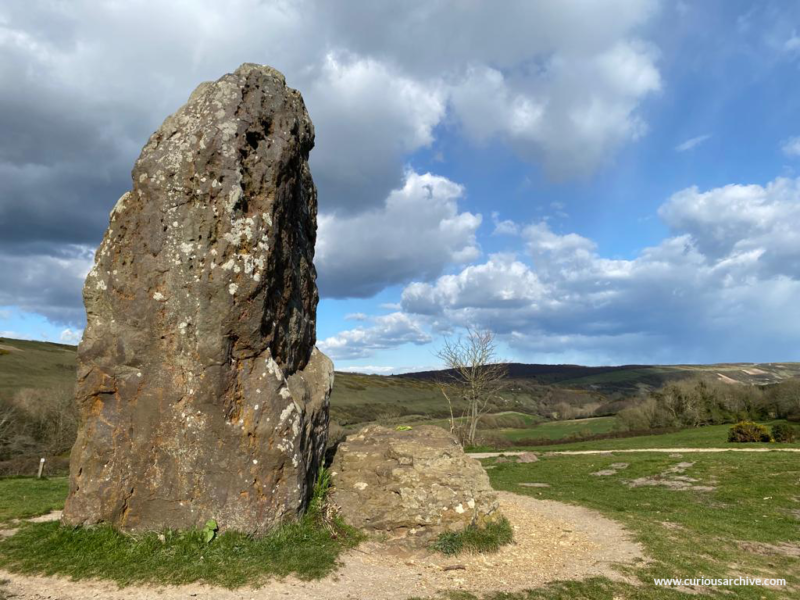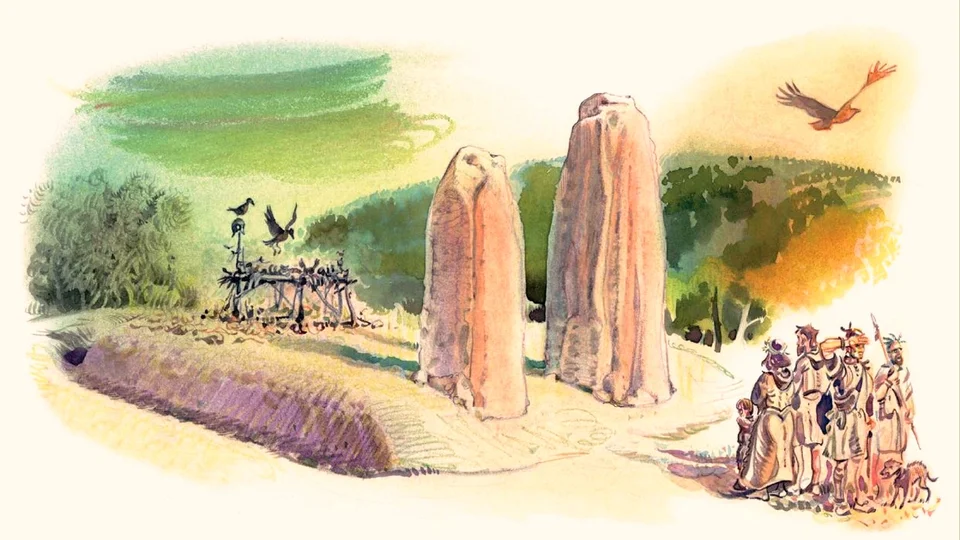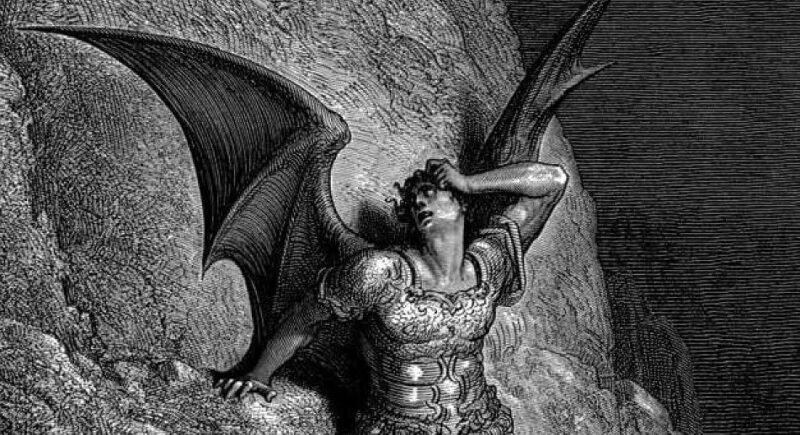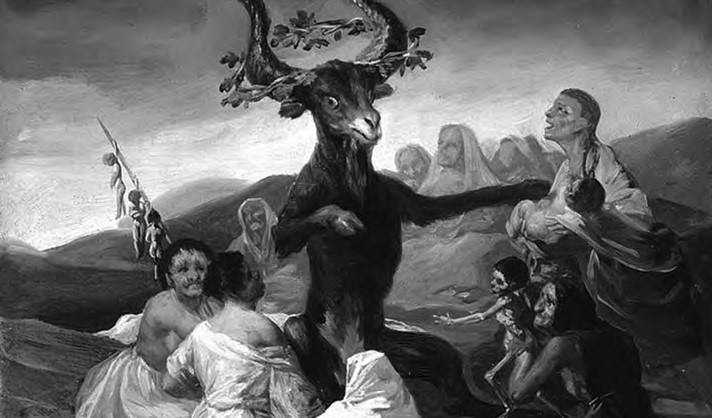Sacred Earth: The Neolithic Longstone on the Isle of Wight

Tucked near the village of Mottistone on England’s Isle of Wight is the Longstone, the remains of a 6000 year old communal long barrow from the Neolithic Period. The site sits at the foot of a large hill who’s peak features south views of the English Channel’s endless blue. A sense of peace is present when standing next to the stones, their isolated location only allowing the sound of the wind to disturb one’s thoughts. Though there may be nothing extraordinary about their appearance, the Longstone has a history of importance spanning it’s original use thousands of years ago up to it’s continued appreciation as a spiritual location today.
History
During the Neolithic Period, communal long barrows like the Longstone were likely used as funerary spaces while simultaneously serving as important religious and social sites within their community. Barrows, also called tumuli, are the mound of earth and stones fixed overtop the graves. A ‘long’ barrow implies a tumuli of greater length marking the location of several graves. The bodies interred would have been stripped of their flesh, and the bones of the dead were mixed together to eliminate ideas of social or monetary status among the deceased. In order to remove the flesh from the bones, the bodies may have been left out in the open for birds and other animals to consume. This is demonstrated in the National Trust illustration below.

So what do you see if you visit the Longstone at Mottistone today? The present Longstone site is unfortunately a shadow of it’s former self. The long barrow remained in it’s intended state until the 1700s when it was destroyed during quarrying. At that point it is believed the stones themselves had been moved from their original location sometime during the Saxon period (c. 410-1066 CE). And during the nineteenth-century a local squire named Lord Dillon had the stones unearthed in the hopes of finding something interesting buried beneath (he didn’t). Still, the Longstone remains an interesting sneak peak into the funerary practices of the people who lived on the island thousands of years ago and are well worth a visit when on the island.
The Stones and their Folklore

While we know the likely historical purpose of the Longstone, a popular legend remains associated with the stones to this day. According to the legend, St Catherine and the Devil held a contest to see who would control the Isle of Wight. Standing on top of St Catherine Down to the east of Mottistone, St Catherine threw the Longstone which landed at the location we see today. The Devil’s much smaller stone fell short and he lost the contest and left the island. The Longstone is said to stand today as a reminder of the triumph of St Catherine’s good over the Devil’s evil.
Other versions of the story say the contest was between the Devil and a giant, or that giants placed the two stones in their current location. Pure speculation — but perhaps the giants are in reference to Nephilim, Biblical giants mentioned in both Genesis and Numbers in the Hebrew Bible and interpreted by some as men who ‘fell away from righteousness‘ or as being the sons of fallen angels. While researching this story I found that some people also tell a third version where the contest is pitted between St Catherine and a giant. While the latter two aren’t as popular as the first, it’s certainly interesting how a story alters as it’s passed down throughout history.
Rumours of the Longstone
There’s plenty of speculation over the use of the Longstone throughout the centuries. Some believe the stones were an important sacred meeting point for ancient Brythonic Druids. Others have suggested that the Longstone might have been used by a Roman mystery cult that worshipped the god Mithras and used the smaller ‘altar’ stone for sacrificing bulls. There have also been rumours that the smaller stone was used for human sacrifice, as well as witchcraft. However, there is no evidence that this was the case and it is considered an unlikely (but spooky) addition to the mythology of the stones.

Other tales associated with the stone include the sacrifice of a white bull by Druids (date unspecified and historical accuracy questionable), and that the site used to contain a ‘rocking stone’, which could be moved by the wind but not by someone with a guilty conscious. On a lighter note, some believe white witches performed a ritual at the Longstone to cleanse the site of an evil aura, giving it the safe and calming atmosphere it has today.
The Longstone Today
In contemporary times, the Longstone acts as an annual meeting place for druids celebrating the solstices and equinoxes. Island Druids have also been known to gather at the Longstone to celebrate Samhain, a Gaelic festival that marks the end of harvest season and the beginning of the dark months of the year. It’s possible that the people who built the Longstone worshipped the sun and the moon since the barrow had been constructed to align west to east, so the Longstone is a fitting location for such celebrations.
The larger stone belonging to St Catherine was vandalised in October of 2007 when someone painted a white Christian cross on the side facing the smaller stone belonging to the Devil. However, upon visiting the stones at the beginning of April 2022 I was unable to find any sign of the graffiti on the larger stone, so it has since washed away. I did however find a small offering of now wilted tulips on the smaller stone. Apparently it’s quite common to find offerings here and I look forward to seeing what other interesting things are left on the smaller stone during my next visit.
Today the Longstone, along with most of the village of Mottistone is owned by the National Trust. The Longstone is also considered a Scheduled Monument, designating it as an important and protected archaeological site in the United Kingdom. Everyone is welcome to visit the Longstone during their stay on the Isle of Wight and can do so free of charge. A small carpark on Strawberry Lane offers free parking as well as the beginning of a footpath that leads to the Longstone site. Wear comfortable shoes as the pathway is on rocky and somewhat uneven ground, and keep an eye out for any interesting (and hopefully wholesome.. no sacrificed bulls, please) offerings on the ‘altar’!

Sources and Additional Reading
Druiden – 3 Sacred Sites for Druids
Great British Ghost Tour – Haunted Mottistone
Island Eye – Ghostly Goings On
Mysterious Britain & Ireland – The Longstone at Mottistone
National Trust – The Longstone at Mottistone
Red Funnel – Isle of Wight Historic Timeline
The Megalithic Portal – Long Stone (IOW)
The Modern Antiquarian – The Longstone of Mottistone
The Paranormal Database – Isle of Wight Ghosts, Folklore and Forteana
Wight Druids – Blessings of Samhain
Wikipedia – The Longstone, Mottistone
Wikipedia – Tumulus
YouTube – Travellin’ Gatherin’ The Longstone, Mottistone Down. Views before the ceremonies.
